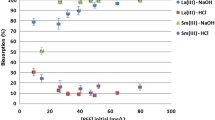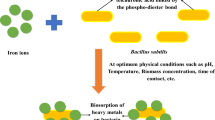Abstract
The presence of heavy metals in the environment is of major concern because of their extreme toxicity and tendency for bioaccumulation in the food chain even in relatively low concentrations. Nickel is toxic and relatively widespread in the environment. It is used in a wide variety of industries such as plating and cadmium–nickel battery, phosphate fertilizers, mining, pigments, stabilizers, and alloys and finds its way to the aquatic environment through wastewater discharge. Several researches in environmental biotechnology have shown that many biosorbents present in our environment have the capacity to remove heavy metals from solutions. This chapter presents the result of studies carried out on absorption of nickel ions from aqueous solutions by Bacillus laterosporus. The effect of various process parameters on the removal of Ni (II) has been investigated. The pseudo second-order model was used to describe the kinetic data. The results of the study showed that the organism can be efficiently used as biosorbent for the removal of divalent nickel from aqueous solution.
Access provided by Autonomous University of Puebla. Download conference paper PDF
Similar content being viewed by others
Keywords
Introduction
Water is considered to be a vital and limited resource. Population growth, industrial developments, and other pressures faced by developing countries have led to structured measures to ensure sustainable management of this important source. Many heavy metals and their compounds have been found toxic, while some are also subjected to biomagnifications. The presence of these heavy metals in wastewaters will pose an important problem for the environment. The discharge of heavy metal into aquatic ecosystem has become a matter of concern in India over the last few decades. The pollutants of serious concern include lead, chromium, mercury, uranium, selenium, zinc, arsenic, cadmium, gold, silver, copper, and nickel [1–5]. Nickel is toxic and relatively widespread in the environment. It is used in a wide variety of industries such as plating and cadmium–nickel battery, phosphate fertilizers, mining, pigments, stabilizers, and alloys and finds its way to the aquatic environment through wastewater discharge [6, 7].
Conventional methods that are used to treat the wastewater containing heavy metals are chemical precipitation, ion exchange, solvent extraction, adsorption, membrane processes, etc. The search for new technology led to biosorption which is a physicochemical process dealing with the interaction of material of biological origin and a contaminant [8]. This chapter reports the effect of contact time and adsorbent dose on Ni (II) sorption by using bacteria Bacillus laterosporus.
Materials and Methods
Preparation of Biosorbent
The biosorbent used for the study was Bacillus laterosporus. The strain was maintained on nutrient agar slants and stored at 4°C with routine transfers in a cycle of 1month. The bacteria were cultured in agitated and aerated liquid media by adopting the shake flask method. Dried biomass was used for the biosorption studies.
Preparation of Stock Solution
All reagents were of analytical reagent grade. A stock solution of 1,000 mg/l of Ni (II) was prepared by using nickel sulfate in double distilled water.
Biosorption Experiments
Biosorption experiments were performed in a rotary shaker using 250-ml Erlenmeyer flask containing 0.2 g of biomass and 50 ppm Ni (II) solution. The concentration of metal ion was determined by using atomic absorption spectrophotometer. The amount of Ni (II) adsorbed by the biomass was calculated from the differences between metal quantity added to the biomass and metal content of the supernatant using the following equation:
where q is the metal uptake (mg metal/g of the biosorbent), v is the liquid sample volume (l), C i is the initial concentration of the metal in the solution (mg/l), C f , the final concentration of metal in the solution(mg/l), and m is the amount of the added biosorbent on the dry basis (g).
Results and Discussion
Effect of Contact Time
Performance of biosorbent on the biosorption of Ni (II) at different contact time was carried out with initial Ni (II) concentration of 50 ppm. Results (Fig. 50.1) show that capacity of biosorption increased with contact time.
Effect of Adsorbent Dose
Experiments were conducted to study the effect of biosorbent dosage on metal removal at room temperature at initial concentration of 50 ppm Ni (II) solution with contact time 1h. It can be observed from (Fig. 50.2) that the metal uptake decreases with increase in adsorbent dosage.
Kinetic Modeling of Ni (II) Adsorption
Kinetics describes the solute uptake rate which in turn controls the resident time of sorbate uptake at the solid–solution interface.
The pseudo second-order rate equation is expressed as
where k 2 is pseudo second-order rate constant.
The experimental data fit well with second-order kinetic model (Fig. 50.3).
Conclusions
The present study shows that Bacillus laterosporus was an effective biosorbent for biosorption of nickel (II) ions from aqueous solutions. The effects of process parameters like contact time and adsorbent dosage were studied. The biosorption could be best described by pseudo second-order kinetic equation.
References
Ahalya N, Ramachandra TV, Kanamadi RD. Biosorption of heavy metals. Res J Chem Environ. 2003;7(4):71–9.
Ajaykumar AV, Naif A, Hilal N. Study of various parameters in the biosorption of heavy metals on activated sludge. World Appl Sci J. 2009;5(Special Issue for Environment):32–40.
Volesky B. Biosorption and me. Water Res. 2007;41:4017–29.
Volesky B. Detoxification of metal-bearing effluents: biosorption for the next century. Hydrometallurgy. 2001;59:203–16.
Volesky B, Holan ZR. Biosorption of heavy metals. Biotechnol Prog. 1995;11:235–50.
Padmavathy V, Vasudevan P, Dhingra SC. Biosorption of nickel (II) ions on baker’s yeast. Process Biochem. 2003;38:1389–1395.
Aksu Z, Donmez G. Binary biosorption of cadmium (II) & Nickel (II) onto dried chlorella vulgaris: coion effect on mano component isotherm parameters. Process Biochem. 41:860–868.
Wang J, Chen C. Biosorbents for heavy metals removal and their future. Biotechnol Adv. 2009;27:195–226.
Author information
Authors and Affiliations
Corresponding author
Editor information
Editors and Affiliations
Rights and permissions
Copyright information
© 2012 Springer India
About this paper
Cite this paper
Kulkarni, R.M., Srinikethan, G., Shetty, K.V. (2012). Biosorption of Nickel (II) from Aqueous Solution Using Bacillus laterosporus . In: Sabu, A., Augustine, A. (eds) Prospects in Bioscience: Addressing the Issues. Springer, India. https://doi.org/10.1007/978-81-322-0810-5_50
Download citation
DOI: https://doi.org/10.1007/978-81-322-0810-5_50
Published:
Publisher Name: Springer, India
Print ISBN: 978-81-322-0809-9
Online ISBN: 978-81-322-0810-5
eBook Packages: Biomedical and Life SciencesBiomedical and Life Sciences (R0)







